Overview of the Global Anemia Problem, Including Iron Deficiency Anemia
The World Health Organization (WHO) defines anemia among women of childbearing age as the condition of having a hemoglobin concentration of < 12.0 g/dL at sea level; among pregnant women it is defined as < 11.0 g/dL. The hemoglobin concentration cutoff level that defines anemia varies by age, gender, physiological status, smoking status, and the altitude at which the assessed population lives.
The primary cause of anemia is iron deficiency, a condition caused by inadequate intake or low absorption of iron, the increased demands of repeated pregnancies—particularly if not well spaced (e.g., fewer than 36 months between pregnancies)—and loss of iron through menstruation. Other causes of anemia include vitamin deficiencies (such as a deficiency of folic acid or vitamin A), genetic disorders, malaria, parasitic infections, HIV, tuberculosis, common infections, and other inflammatory conditions. While iron deficiency anemia (IDA) accounts for about one-half of all anemia cases, it often coexists with these other causes.
Iron deficiency anemia is most common during pregnancy and in infancy, when physiological iron requirements are the highest and the amount of iron absorbed from the diet is not sufficient to meet many individuals’ requirements (Stoltzfus and Dreyfuss 1998). Anemia’s effects include increased risk of premature delivery, increased risk of maternal and child mortality, negative impacts on the cognitive and physical development of children, and reduced physical stamina and productivity of people of all ages (Horton and Ross 2003). Globally, IDA annually contributes to over 100,000 maternal deaths (22 percent of all maternal deaths) and over 600,000 perinatal deaths (Stoltzfus, Mullany, and Black 2004). Key anemia control interventions include promoting a diversified diet, iron-folic acid (IFA) supplementation during pregnancy, iron fortification of staple foods, prevention and treatment of malaria, use of insecticide-treated bed nets, helminth prevention and control, delayed cord clamping, and increased birth spacing.
Maternal Anemia in Honduras
The prevalence of anemia among pregnant women in Honduras is 19 percent, making it a mild public health problem as defined by WHO standards1 (SS, INE, and ICF International 2013). In terms of anemia severity, the majority of cases among pregnant and breastfeeding or non-pregnant women reported in the 2011/2012 Honduras Demographic and Health Survey (HDHS) are classified as mild or moderate.2 Less than one percent of anemia cases among these groups of women are diagnosed as severe. Between 2005/2006 and 2011/2012, the prevalence of anemia fell from 21 percent, 21 percent, and 18 percent among pregnant, breastfeeding, and non-pregnant women, respectively. The largest percentage decrease over the six-year period was among breastfeeding women (30 percent), followed by non-pregnant (17 percent) and pregnant (12 percent) women (SS, INE, and Macro International 2011/2012).
Falter Points in Women's Consumption of Iron-Folic Acid During Pregnancy
WHO recommends that all pregnant women receive a standard dose of 30–60 mg iron and 400 μg folic acid beginning as soon as possible during gestation (WHO 2012). Ideally, women should receive iron-containing supplements no later than the first trimester of pregnancy, which means ideally taking 180 tablets before delivery. It is important to note, that many countries aim for women to receive 90 or more tablets during pregnancy.
Figure 1 shows a decision-tree analysis of how well the Honduran antenatal care (ANC) system distributes IFA, and identifies four potential points at which the system might falter (highlighted in orange). The figure tracks the number and percentage of women who obtained ANC, those who subsequently received and consumed at least one IFA tablet, and those who consumed the ideal minimum number of tablets.3 All data are based on HDHS questions asked of women who were in permanent unions and had been pregnant in the five years prior to being interviewed4 (SS, INE, and ICF International 2013.)
Figure 1. Analysis of Falter Points Related to Distribution and Consumption of IFA through Honduras’ ANC Program in 2011/2012, Women of Reproductive Age (15–49 Years) n = 22,757
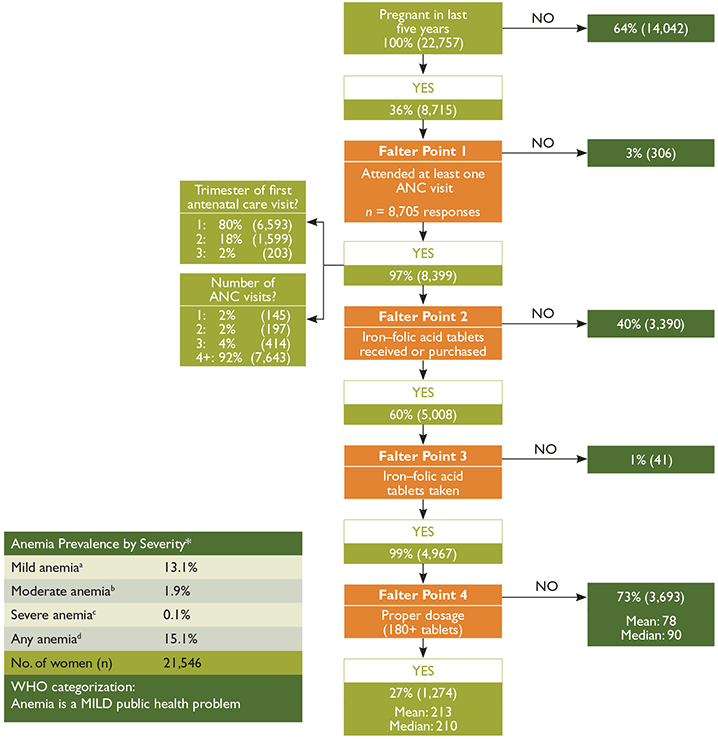
Main Conclusions: Given Honduras’ high coverage rate, ANC provides an outstanding platform for IFA distribution. However, among women who were pregnant in the last five years, had at least one ANC visit, and took at least one IFA tablet, only 27 percent received and took the ideal minimum number of tablets. Falter Points 2 and 4 are the most critical shortcomings of the system. Supply is a considerable constraint.
*Percent of women 15–49 based on Hemoglobin levels, Hb (g/dL)
aNPW 10.0≤Hb≤11.9, PW 10≤Hb≤10.9 bNPW 7.0≤Hb≤9.9, PW 7.0≤Hb≤9.9 cNPW Hb<7.0, PW Hb<7.0 dNPW Hb<12, PW Hb<11
Non-responses, no data were recorded to “No” for “At least one ANC visit?”, “IFA tablets received?” and “IFA tablets taken?” and to zero for “Number of tablets taken?”
Anemia prevalence data are provided as a reference point, signaling the general order of magnitude of the anemia public health problem. The ANC utilization data is based on self-reported data of women 15–49 years in permanent unions and pertains to their last pregnancy in the last five years prior to the DHS survey.
Source: Calculations and anemia levels are from the Honduras Demographic and Health Survey (2011/2012).
Many supply-side aspects—including both adequacy of IFA tablet supplies and technical knowledge and practices of ANC providers—need to be considered when assessing how well an ANC program delivers IFA. In addition, as Falter Point 4 in Figure 1 clearly shows, the provision of IFA tablets to a pregnant woman is a necessary but not sufficient condition for the woman to consume the tablets, particularly at the ideal minimum level. Thus, demand-side factors also play a critical role in determining the coverage and effectiveness of a program. These include whether or not women seek ANC and the timing and number of visits, as well as the extent to which women are aware of the significance of anemia and IFA, ask for IFA tablets, and comply with the IFA regimen.
Understanding the relative significance of each falter point makes it possible to prioritize them for more in-depth analysis, providing a first step in an evidence-based approach to systematically improving the program. The DHS does not collect information on the number of IFA tablets received by women. In the case of Falter Point 4, this lack of data creates ambiguities that make it impossible to fully understand whether shortcomings of the system relate primarily to supply- or to demandside factors. Despite this limitation, the decisiontree analysis presented in Figure 1 still enables prioritizing the falter points for more in-depth analysis and action at the national, district, and health center levels.
Analysis of Falter Points
Falter Point 1:
Did not attend at least one ANC visit
Only three percent of women did not have at least one ANC visit.
ANC’s high coverage gives it great potential as a vehicle for providing IFA.
Falter Point 2:
Did not receive or purchase at least one IFA tablet
Of the women who had at least one ANC visit, 40 percent did not receive or purchase any IFA tablets.
This supply-side constraint may be due to various system/supply-side performance shortcomings, which could reflect: (1) inadequate supply (e.g., stockouts); (2) inadequate provider knowledge; or (3) inadequate provider practices, whereby IFA may not have been provided. As Figure 2 shows, this is the second-most important falter point among all pregnant women in Honduras.
Unfortunately, the HDHS does not report the source(s) of the IFA tablets women received or purchased, and a small percentage of women attending ANC get IFA tablets from a different source. While only three percent of Honduran women who received or purchased IFA did not have any ANC visits (not shown), we cannot ascertain whether or not those who received ANC obtained their IFA from their ANC provider. However, women who attend ANC may be more likely to be aware of, to value, and also to take IFA tablets, regardless of where they obtain them. Thus, we would expect a high correlation between the number of women who had at least one ANC visit and those who received or purchased IFA, which is consistent with the data. Women who have one or more ANC visits and who did not receive any IFA represent a missed opportunity to reduce the risk of anemia among a high-risk population.
Falter Point 3:
Did not take at least one IFA tablet
Of the women who received IFA, one percent did not consume any tablets.
This demand-side constraint is extremely small and may be due to women not understanding the significance of anemia and/or the significance of IFA. This misunderstanding may reflect: (1) inadequate provider counseling and follow-up; (2) women’s beliefs about actual or possible side effects; or (3) sociocultural factors.
Falter Point 4:
Did not consume 180 or more IFA tablets
Of the women who received and took IFA, 73 percent did not consume the ideal minimum of 180 IFA tablets.
This constraint results from a combination of supply- and/ or demand-side factors. Figure 1 suggests two situations that may contribute to this falter point: 20 percent of women who received ANC began their care after the first trimester, and the 8 percent who had fewer than WHO’s recommended four ANC visits during their last pregnancy may have started their ANC too late or may not have had enough visits to receive 180 tablets (given IFA distribution protocols). Both of these scenarios are likely contributors, but further research is needed to establish their relative importance, as well as the significance of other possible causes.
Globally, research has found that the following situations often contribute to Falter Point 4: (1) providers do not have access to adequate supply; (2) women do not receive adequate tablets because they have little access to care, start ANC late, or do not have enough ANC visits, making it difficult to obtain 180 tablets (given IFA distribution protocols); (3) providers do not provide adequate counseling or follow-up; (4) women do not adhere to the regimen, which may be due to difficulty in remembering to take the tablets daily, not knowing all the tablets are necessary, fear of having a big baby, side effects, or tablet-related issues (taste, size, color, coating, packaging/storage problem). Further research is needed to determine the underlying factors contributing to this falter point in Honduras.
Figure 2. Number of IFA Tablets Received and Taken by Women During Pregnancy, Honduras, 2005/2006–2011/2012
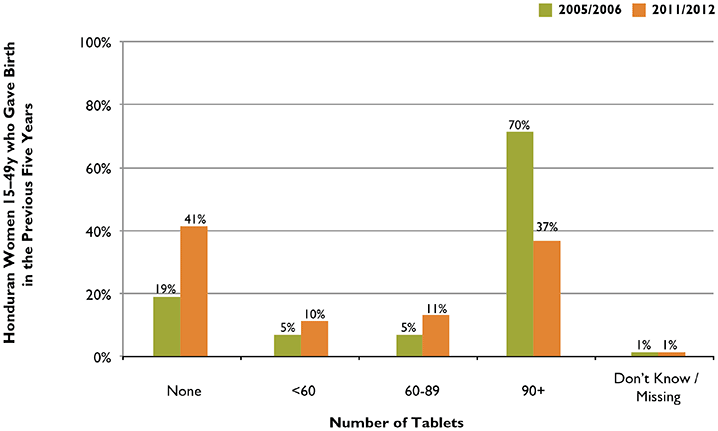
Table 1. ANC and IFA Coverage During Last Pregnancy in the Last Five Years by Department, Residence Area, and Wealth, Honduras, 2011/2012
| Characteristic | No. of Women with a Live Birth - Last 5 Years | Received ANC | Took 1 + IFA Tablet | ||
|---|---|---|---|---|---|
| Number | Percent | Number | Percent | ||
| Department | |||||
| Residence | |||||
| Wealth | |||||
| Atlántida | 398 | 379 | 95.2% | 216 | 54.3% |
| Colón | 333 | 323 | 97.0% | 177 | 53.3% |
| Comayagua | 535 | 519 | 97.0% | 356 | 66.6% |
| Copán | 410 | 385 | 93.9% | 230 | 56.1% |
| Cortés | 1,473 | 1,423 | 96.6% | 860 | 58.4% |
| Choluteca | 415 | 398 | 95.9% | 263 | 63.4% |
| El Paraíso | 428 | 409 | 95.6% | 244 | 56.9% |
| Francisco Morazán | 1,375 | 1,355 | 98.5% | 865 | 62.9% |
| Gracias a Dios | 106 | 102 | 96.2% | 57 | 53.8% |
| Intibucá | 232 | 224 | 96.6% | 105 | 45.1% |
| Islas de la Bahía | 71 | 71 | 100% | 50 | 70.9% |
| La Paz | 226 | 221 | 97.8% | 159 | 70.4% |
| Lempira | 339 | 331 | 97.6% | 186 | 54.8% |
| Ocotepeque | 163 | 160 | 98.2% | 111 | 68.4% |
| Olancho | 522 | 503 | 96.4% | 251 | 48.0% |
| Santa Bárbara | 466 | 449 | 96.4% | 285 | 61.1% |
| Valle | 169 | 166 | 98.2% | 98 | 57.8% |
| Yoro | 606 | 580 | 95.7% | 342 | 56.4% |
| Urban | 3,934 | 3,824 | 97.2% | 2,427 | 61.7% |
| Rural | 4,335 | 4,173 | 96.3% | 2,428 | 56.0% |
| Lowest 40% | 3,552 | 3,373 | 95.0% | 1,925 | 54.2% |
| Highest 40% | 3,048 | 3,005 | 98.6% | 1,731 | 56.8% |
| National Average | 8,269 | 7,996 | 96.7% | 4,854 | 58.7% |
Figure 3. Percentage of Women Who Had at Least One ANC Visit and Received at Least One IFA Tablet by Department, Honduras, 2011/2012
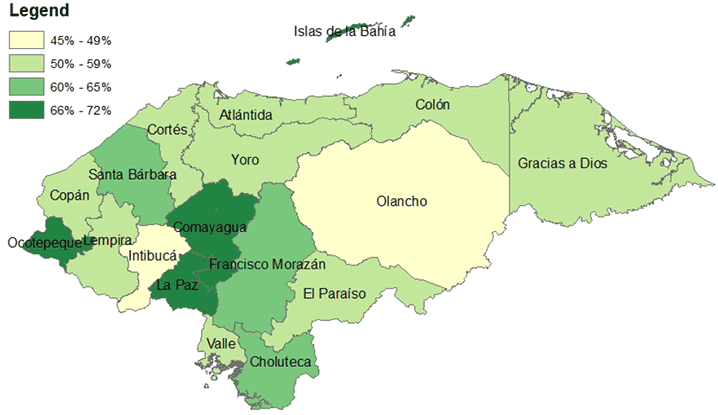
Analysis by Sociodemographic Variables and Trends over Time
A comparison of HDHS data from 2005/2006 and 2011/2012 reveals that Honduras has made great progress in increasing ANC coverage and reducing the prevalence of anemia among women. Ninety-seven percent of pregnant women are receiving ANC and the prevalence of anemia has dropped from 19 percent to 15 percent among women of childbearing age. As seen in Table 1, ANC coverage is greater than 93 percent across all departments, residence areas, and wealth quintiles. This impressive equity in coverage is rare in low- and middle-income countries. Although these figures are encouraging, IFA coverage (defined as the percentage of women, among all women who were pregnant in the past five years, who received and took at least one IFA tablet) has dramatically decreased, from 81 percent in 2005/2006 to 59 percent in 2011/2012. IFA coverage varies by 26 percentage points among departments, from 45 percent in Intibucá to 70.9 percent in Islas de la Bahía. Urban women and those in the highest wealth quintiles are more likely to receive IFA than their rural and lower-wealth-quintile counterparts, by six and three percentage points, respectively. The large discrepancies in ANC and IFA coverage suggest that the supply and distribution of IFA tablets through the ANC system may be a major barrier to women taking the full IFA regimen.
Figure 2 underscores the overall decrease in the number of IFA tablets taken and received by women between 2005/2006 and 2011/2012. The percentage of women receiving and/or taking no IFA tablets more than doubled, rising to 41 percent, compared to 19 percent observed in 2005/2006. Furthermore, the percentage of women taking 90 or more IFA tablets fell by 33 percentage points, to 37 percent.
Table 2. Number and Timing of Antenatal Care Visits, Honduras, 2005/2006 and 2011/2012
| Indicator | 2005/2006 | 2011/2012 | Change in Coverage | Percentage Change |
|---|---|---|---|---|
| Number of ANC Visits | ||||
| Month of First Visit | ||||
| 0 | 8.0% | 3.3% | -4.7% | -58.8% |
| 1 | 2.0% | 1.7% | -0.3% | -15.0% |
| 2-3 | 9.0% | 6.1% | -2.9% | -32.2% |
| 4 + | 80.8% | 88.9% | 8.1% | 10.0% |
| Don't Know/No Data | 0.2% | 0.1% | -0.1% | -50.0% |
| No Antenatal Care | 8.0% | 3.3% | -4.7% | -58.8% |
| < 4 | 68.7% | 77.6% | 8.9% | 13.0% |
| 4-5 | 16.1% | 14.4% | -1.7% | -10.6% |
| 6-7 | 6.2% | 4.0% | -2.2% | -35.5% |
| 8 + | 0.9% | 0.8% | -0.1% | -11.1% |
| Don't Know/No Data | 0.1% | 0.0% | -0.1% | -100.0% |
Table 2 highlights two key ANC indicators in Honduras: the number of ANC visits and the timing of the first visit. Over the six-year period between 2005/2006 and 2011/2012, more women obtained their first ANC visit within their first trimester of pregnancy and the percentage of women who had four or more ANC visits increased by 10 percent. Continued improvement of the percentage of women receiving ANC early in pregnancy has the potential to increase the number of women taking the ideal minimum of 180 IFA tablets (addressing Falter Point 4) and further reduce the nationwide prevalence of anemia.
Analysis by Geographic Region
The map in Figure 3 shows the variation by department in the percentage of women who had at least one ANC visit and who received at least one IFA tablet. The lowest coverage rates, between 45 percent and 49 percent, occur in Olancho and Intibucá, while the highest coverage rates, between 66 percent and 72 percent, are in Ocotepeque, La Paz, and Comayagua. Given the high overall percentage of women receiving ANC throughout Honduras, supporting the distribution of IFA through ANC providers may reduce barriers to women obtaining IFA, taking advantage of the missed opportunity to get more women to take a full IFA-tablet regimen during pregnancy.
Analysis by Number of ANC Visits
Figure 4 shows the relationship between the number of IFA tablets taken by women who had at least one ANC visit and the number of ANC visits they had during their last pregnancy. Fifty-one percent of women who had at least one ANC visit took, at most, one-quarter (45) of the ideal minimum number of IFA tablets. Women who had more visits were generally likely to receive and take more IFA tablets, but the relationship is weak; only 17 percent of women who had four or more ANC visits took the ideal minimum of 180 IFA tablets. Learning what accounts for this ceiling is a critical challenge to improving the effectiveness of the ANC-based distribution of IFA in Honduras.
Figure 4. ANC Distribution of IFA Tablets: Number of Tablets Received and Taken According to Number of ANC Visits, Honduras, 2011/2012
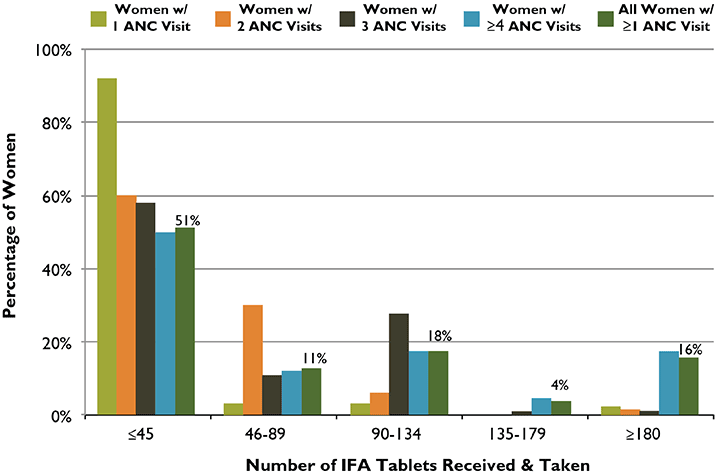
Overall Conclusions and Recommendations
Figure 5 presents the obstacles among all women, including those who did not receive ANC during their pregnancy, to taking the minimum ideal number of IFA tablets. In Honduras, Falter Points 2 and 4 are the greatest barriers. Falter Point 2 represents a greater barrier in Honduras than in all but two of the countries assessed for this analysis. Improving the delivery of IFA supplementation in Honduras will therefore rely heavily on identifying and addressing program gaps in IFA supply management and health workers’ practices. Ensuring that IFA tablets are offered and provided through ANC visits, and addressing other points mentioned above, under “Analysis of Falter Points,” may also lead to more women taking a minimum of 180 tablets.
Figure 5. Relative Importance of Each Falter Point in Honduras: Why Women Who Were Pregnant in the Last Five Years Failed to Take the Ideal Minimum of 180 IFA Tablets
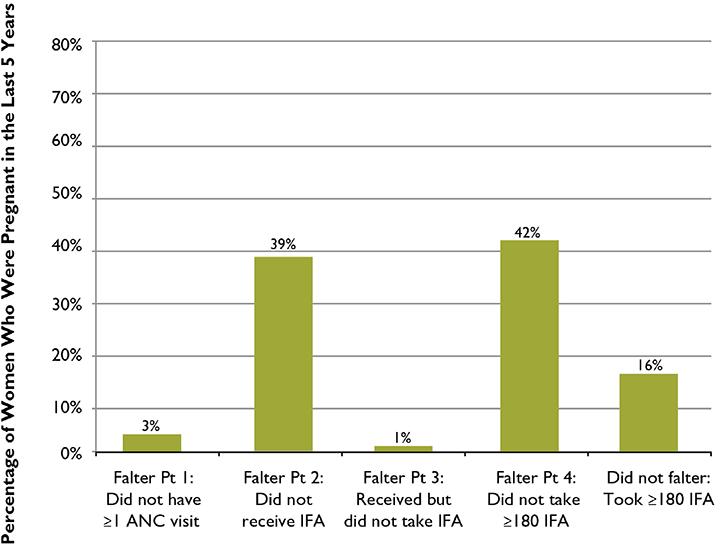
In 1990, the Reproductive Age and Mortality Survey (RAMOS) indicated that the maternal mortality rate (MMR) in Honduras was 182 maternal deaths per 100,000 live births, well above the previous figure of 50 reported in 1983, based only on hospital estimates. The startlingly high number created momentum for new policy measures by the Ministry of Health, which prioritized maternal health and expanded the country’s health infrastructure. As a result, Honduras’s MMR dropped to 108 by 1997 (Shiffman, Stanton, and Salazar 2004). However, recent estimates suggest that the MMR in Honduras has increased to 119, putting the country offtrack in efforts to meet its target of reducing the MMR to 46 or below by 2015 (GOH, UNDP, and Asdi 2010).
Ensuring access to quality ANC will be essential to achieving Millennium Development Goal (MDG) 5: improving maternal health and reducing maternal mortality. Honduras’s National Health Plan 2010– 2014 reprioritizes maternal health and identifies reducing maternal and child mortality, through policies implemented through the Accelerated Reduction of Maternal and Child Mortality program, as one of three areas in need of urgent attention. As this rapid assessment of the distribution of IFA tablets through ANC suggests, there is substantial room for improving both the supply and demand sides of the country’s ANC program. Improving the distribution of IFA through the ANC program is an important strategy for preventing and controlling anemia in Honduras, and for improving the nutrition and health status as well as the mental and physical capacity of women of reproductive age.
Footnotes
1 WHO categorizes the severity of anemia as a public health problem according to the condition’s prevalence: < 5 percent, no public health problem; 5–19.9 percent, mild; 20–39.9 percent, moderate; ≥ 40 percent, severe.
2 The DHS hemoglobin levels used to diagnose the severity of anemia in non-pregnant women differ from those specified by WHO. The DHS cutoffs for pregnant (P) and non-pregnant (NP) women in hemoglobin g/ dL are mild, 10.0–10.9 (P), 10.0–11.9 (NP); moderate, 7.0–9.9 (P), 7.0–9.9 (NP); severe, < 7.0 (P), <7.0 (NP); any, < 11.0 (P), < 12.0 (NP).
3 The HDHS asked about IFA tablets or capsules; this brief refers to all forms as “tablets.”
4 The HDHS provides a population-based, nationally representative sample of all women in Honduras.
References
Gobierno de Honduras (GOH), United Nations Development Programme (UNDP), and Agencia Sueca de Cooperación Internacional para el Desarrollo (Asdi). 2010. Objectivos de Desarrollo del Milenio, Honduras 2010: Tercer informe de país. San José, Costa Rica: Litografía e Imprenta Lil, S.A.
Horton, S., and J. Ross. 2003. “The Economics of Iron Deficiency.” Food Policy 28(1):51–75.
Secretaría de Salud (SS), Instituto Nacional de Estadística (INE), and ICF International. 2013. Encuesta Nacional de Salud y Demografía 2011–2012. Tegucigalpa: Secretaría de Salud (SS), Instituto Nacional de Estadística (INE), and ICF International.
Secretaría de Salud (SS), Instituto Nacional de Estadística (INE), and Macro International. 2006. Encuesta Nacional de Salud y Demografía 2005–2006. Tegucigalpa: SS, INE, and Macro International.
Shiffman, J., C. Stanton, and A. P. Salazar. 2004. “The Emergence of Political Priority for Safe Motherhood in Honduras.” Health Policy and Planning 19(6):380–90.
Stoltzfus, R. J., and M. L. Dreyfuss. 1998. Guidelines for the Use of Iron Supplements to Prevent and Treat Iron Deficiency Anemia. Washington, DC: ILSI Press.
Stoltzfus, R. J., L. Mullany, and R. E. Black. 2004. “Iron Deficiency Anemia.” In Comparative Quantification of Health Risks: Global and Regional Burden of Disease Attributable to Selected Major Risk Factors. M. Ezzati, A. D. Lopez, A. Rodgers, and C. J. L. Murray, eds. Geneva: World Health Organization.
World Health Organization. 2012. Guideline: Daily Iron and Folic Acid Supplementation in Pregnant Women. Geneva, World Health Organization.